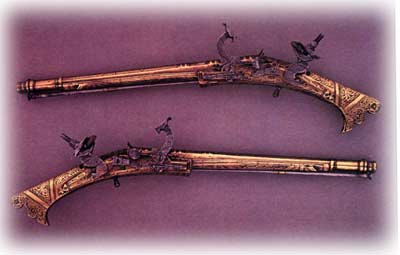|
Especially distinctive of Scottish craftsmanship are the
firearms, and in particular the all-metal pistols, produced
during the 17th and 18th centuries. Records of Scottish
firearm makers go back to the close of the 16th century,
and the earliest Scottish pistols known are dated 1598.
From the Whitelaw collection comes a pair of all-brass pistols
(no 30 left) dated 1624 on the fences (or pan terminals)
and 1626 on the barrels. Since barrels and locks were probably
made by different craftsmen from the same workshop, it is
not surprising to find parts of different date assembled
in the same weapon. Occasionally stocks of this early form
may be of wood, with metal mounts; otherwise they were of
brass, but not of iron. Whether of wood or of brass the
stocks are slim, with distinctive fish-tailed butts, a traditional
description but now perhaps misleading, since it has been
recently suggested that the shape was originally in imitation
of the head and beak of a bird.
 It
seems to have been usual at this period to make pistols
in pairs, one left-handed and one right-handed. They were
not carried in holsters, and so did not have trigger guards.
Instead they were provided with belt hooks. There must have
been some risk in carrying the pistols thus when loaded,
for they had no safety catches. The lock mechanism was a
Scottish version of the snaphance type, a predecessor of
the true flintlock, in which the steel and pan cover are
made separately. When pulled back the cock was held by a
catch or sear protuding through the lock-plate and engaging
with the projecting tail of the cock. In order to prevent
the cock from going too far forward after release of the
trigger a buffer is screwed to the lock-plate. The flat-sided
barrels are elaborately moulded at the muzzles and of very
small calibre. It
seems to have been usual at this period to make pistols
in pairs, one left-handed and one right-handed. They were
not carried in holsters, and so did not have trigger guards.
Instead they were provided with belt hooks. There must have
been some risk in carrying the pistols thus when loaded,
for they had no safety catches. The lock mechanism was a
Scottish version of the snaphance type, a predecessor of
the true flintlock, in which the steel and pan cover are
made separately. When pulled back the cock was held by a
catch or sear protuding through the lock-plate and engaging
with the projecting tail of the cock. In order to prevent
the cock from going too far forward after release of the
trigger a buffer is screwed to the lock-plate. The flat-sided
barrels are elaborately moulded at the muzzles and of very
small calibre.
An outstanding feature of the pistols,
and one for which the all-metal construction was entirely
suitable, is the elaborately engraved decoration of lock,
stock and barrel. The rosette is prominent, and the ornament
is largely foliate in style, but other elements such as
the key pattern border are reminiscent of late Celtic design.
On the lock-plate is a panel with the initials IL, which
may be those of a member of the Low family, of Dundee.
During the Civil War Dundee suffered
a raid by Montrose's troops in 1645, and in 1651 was sacked
by General Monk's forces, thereby losing its pre-eminence
in the manufacture of firearms in Scotland. The city nevertheless
thereafter regained a place amongst a series of centres,
which included Edinburgh, Brechin, Edzell, Aberdeen, Old
Meldrum, Elgin and Inverness, all supplying the needs of
the east and north-east coasts. The chief centre for the
supply of the Highlands was Doune, in Perthshire, where
an industry seems to have started soon after the Civil War,
to last for nearly a century and a half.
Article taken from 'European Arms &
Armour- at Kelvingrove' by J G Scott, for more information
visit Kelvingrove Museum and Art Gallery, Glasgow, Scotland.
Further reading 'THE SCOTTISH PISTOL',
by Martin Kelvin
|


